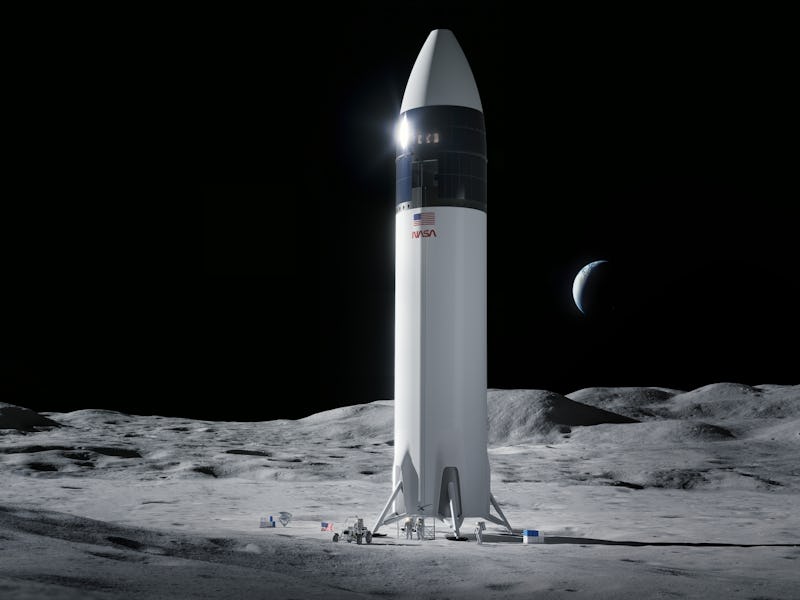SpaceX vs. Blue Origin: How Elon Musk beat Jeff Bezos to the moon
Here’s what NASA’s Artemis contract means for two of the biggest players in the private space race.

NASA’s reliance on SpaceX to make its space exploration ambitions a reality just got a little greater — almost $3 billion greater. On April 17, SpaceX won a $2.89 billion contract for exclusive rights to provide a Moon lander for NASA to use in its flagship mission of the decade.
The lander is the third, crucial component of the Artemis missions — the name given to NASA’s revived lunar explorations which ended half a century ago with the Apollo missions As part of Artemis, NASA’s Space Launch System rocket will bring astronauts to the Moon’s orbit, tucked safely inside an Orion crew module. The astronauts will then transfer to SpaceX’s Starship spacecraft — still in prototype — in order to make the descent to the surface, and, after their science is done, use it to ascend back to the Orion module and fly home.
Aside from the sheer size of the sum of cash, this contract is a really big deal. Originally, SpaceX wasn’t supposed to build the lander alone. Jeff Bezos’ Blue Origin had convened a “National Team'' with a host of aerospace veteran companies, including Lockheed Martin, Northrop Grumman, and Draper to develop a lander called Blue Moon. Defense contractor Dynetics had also been initially working on a prototype. NASA gave all three companies preliminary contracts to build a design and then planned to accept two bids for the mission itself. But Blue Origin and co. and Dynetics didn’t make the cut.
In the past, NASA has chosen multiple companies to work separately on the same project to encourage competition and ensure it has a backup plan. But SpaceX’s proposal was the only one NASA could afford, according to documents obtained by The Washington Post. With only so much money to play with, NASA has placed their bet on Elon Musk’s company delivering the goods.
What does this mean for Blue Origin?
Jeff Bezos with Blue Origin’s lunar lander "Blue Moon."
The fate of Bezos’ Blue Moon lander is now in jeopardy, as it was being specifically developed for the Artemis mission. This is not the case for Starship — that craft is an ongoing project for SpaceX and ultimately designed to take humans to Mars, whether they be NASA astronauts or not.
“The National Team doesn’t have very much information yet,” a Blue Origin spokesperson tells Inverse. “We are looking to learn more about the selection.”
Of the four companies, Blue Origin and Draper lose out the most, since Lockheed and Northrup are both already working on other elements of the Artemis mission.
Lockheed Martin has already built and delivered the first Orion spacecraft to NASA. The spacecraft, called the Orion Artemis 1, will be part of NASA’s first uncrewed Artemis mission scheduled for launch later in 2021. The Orion module will be launched on top of the Space Launch System rockets, sent to orbit the Moon, and then return to Earth about three weeks later. It’s a dry run for the later Artemis missions that will have a crew aboard.
Northrop Grumman is building critical rockets for the Space Launch System. Two of Northrop’s Flight Support Booster rockets, or FSB-1’s, will provide more than 75 percent of the thrust for a launch of the SLS, according to a company press release. Each rocket is 154 feet in length and can produce 3.6 million pounds of maximum thrust.
Blue Origin faces setbacks elsewhere as well. The first launch of its heavy-lift rocket, called New Glenn, has been delayed from late 2021 into late 2022. It also lost a five-year contract to transport national security equipment into space for the Department of Defense in August 2020. The DoD instead selected SpaceX and the United Launch Alliance, which is a joint rocket venture from Lockheed Martin and Boeing.
Even Amazon, another Bezos company, isn’t relying on Blue Origin to launch its Project Kuiper internet satellites. Amazon awarded a contract to ULA earlier this week to put the satellites in orbit, during nine launches and an undisclosed time frame.
What does this mean for SpaceX?
SpaceX’s Falcon 9 rocket.
SpaceX’s ambitions look beyond the Moon towards Mars. The Red Planet is the eventual goal for the Starship spacecraft. NASA’s Artemis mission is a lucrative pit stop, and Musk has said the Starship’s journey to Mars could take place as soon as 2024.
Musk has planned the Starship as a Mars-bound spacecraft for years, initially calling earlier iterations the “Mars Colonial Transporter” and “Interplanetary Transport System.” It is still in prototype tests.
The Artemis decision cements Musk’s firm as one of NASA’s most trusted vendors. SpaceX has already flown six astronauts to the International Space Station as part of NASA’s Commercial Crew Program and is set to bring four more astronauts to the space station this week for Crew-2. This makes it the only private company NASA has used to launch astronauts into orbit. Boeing, another company NASA has tapped to launch future crews to the ISS, is still conducting uncrewed test launches of its Starliner ship
The Starship prototypes have made four high-altitude flight tests similar to the one planned for this week, but the outcomes have been mixed. They’ve all flown, but all have exploded either in the air or shortly after landing. The second-to-last test, known as SN10, actually landed in one piece but exploded eight minutes later.
As Blue Origin faces continual setbacks, the future only looks bright for SpaceX. It’s the only private company that has actually brought astronauts to the ISS, and if it continues on the current trajectory, it might get us back on the Moon, too.